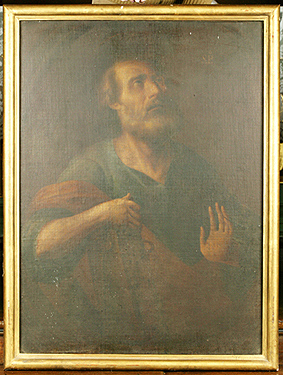The piece of the month of May 2006
APOSTOLATE OF THE PAINTER FRANCISCO PALACIOS
Javier Azanza López
Chair of Navarrese Heritage and Art
To the northwest of Navarre, along a very broken term dominated by mountains of medium height and furrowed by multitude of small fluvial currents, extends the Valley of Basaburúa, integrated by a total of eleven small localities in addition to the hamlet of Aizaroz. Basaburúa is a territory of prehistoric sites and dolmen sectors, an enclave of old forges and arms factories, a departure point for Indians in search of fortune and the scene of famous battles. And it has also been the fortunate and zealous depositary of a pictorial ensemble from the brushes of a disciple of the great Diego Velázquez: the Apostolate of the parish of San Pedro de Arrarás, the work of Francisco Palacios.
Francisco Palacios was a painter from Madrid born at an undetermined date between 1622 and 1625 who, according to Palomino, showed a special disposition for the portrait genre, in spite of the fact that his scarce production known up to the moment sample shows him as a painter of still lifes and religious scenes. In his still lifes, painted directly from life as recommended by his master Velázquez, he used a light and vaporous brushstroke based on loose touches that dotted the canvas, while in his religious themes he was more conventional sample . In recent years the figure of Palacios has become topical due to the attribution made to this painter by Alfonso Pérez Sánchez of the famous canvas of the Academia de San Fernando El Sueño del Caballero, traditionally considered by Antonio Pereda due to the similarity of the concept and attributes with his paintings of "vanitas".
There are very few canvases known today by Francisco Palacios, including attributions. For this reason, the series of the Apostleship preserved in the parish church of San Pedro de Arrarás, which contributes to considerably increase the Catalog of the painter's works, becomes even more important. The Apostolate painted by Francisco Palacios is represented according to the ideals of the Counter-Reformation. The Apostles appear half-length, girded with tunic and mantle, in a three-quarter position, cut out against a dark background from which the figures emerge powerfully. The painter from Madrid proposes an individual representation, giving each image a pretended illusion of portrait and reaching expressions full of interior character and calm gesturalism. The canvases show a careful illumination coming from a spotlight that mainly affects the faces, but without neglecting other elements such as hands and clothing.
As happens in many of these groups, it is very possible that it was completed with a canvas of the Savior, which has not been preserved; this is suggested by the fact that six of the Apostles turn their bodies to the left and the other six to the right, flanking the figure of Christ on either side. All of them are identified, in addition to their symbols, by the name that they incorporate in the upper part of the canvas and in the angle towards which they turn, except in the cases of James the Less and St. Thomas in which the name appears behind their backs. Some also incorporate the Book of the Gospels as an endorsement of their evangelizing work.

Saint Jude Thaddeus. Francisco Palacios (2nd third century XVII)
Among the Apostles who turn to the left, and who therefore in a hypothetical reconstruction would be located to the right of the Savior, is Saint Peter, who undoubtedly must have escorted the image of Christ; in this regard, Francisco Pacheco already pointed out, on the authority of Juan Molano, that "the good order of things requires that Peter, Prince of the Apostolic Senate, should have the right side of the Lord". In fact, the iconographic representation is largely in line with that of proposal by the Andalusian painter and treatise writer, master of Velázquez, who in turn took his sources of inspiration from De Historia SS. Imaginum by the aforementioned Molano and the Flos Sanctorum by Pedro de Ribadeneyra. He is not represented as the oldest of the apostles, but rather sample an intermediate age between the younger Paul and his older brother Andrew. The expression of his face, with careful features, denotes Palacios' good workmanship. He has a clear forehead and thick but not long hair on both sides, a short and round beard, almost unpopulated eyebrows and a crooked and somewhat riveted nose; he raises his look of clouded eyes upwards, in an attitude of contrition after having denied Christ and imploring forgiveness for his sin. He wears a blue tunic and an orange or ochre-colored mantle. From his right hand hang the symbolic keys of the Kingdom of Heaven, one of gold and the other of silver, both joined by a cord, symbol of his power to bind and loose, to forgive sins and to excommunicate, which Christ granted to the Prince of the apostles, according to the Gospel passage of St. Matthew; these keys are together because the power to open and the power to close are one and the same.

San Pedro. Francisco Palacios (2nd third of the 17th century).
That of Judas Thaddeus, brother of James the Less, is one of the most accomplished canvases in Francisco Palacios' Apostolate. Although his most frequent attribute is a mace, instrument of his martyrdom by clubbing before a statue of Diana, sometimes it is replaced by a sword, axe, halberd and even by an architect's square; this is what we appreciate for example the Apostolates of Gerad Seghers, Anthon Van Dyck or Murillo's workshop, and so it happens in the present occasion. Almost half hidden by the cloak, he holds in his left hand the book of the Gospels as a testimony of his preaching of the Christian doctrine in Syria and Mesopotamia together with Saint Simon. The expression of his face, with its careful factions and a narrowed gaze upwards, denotes Palacios's good work.
